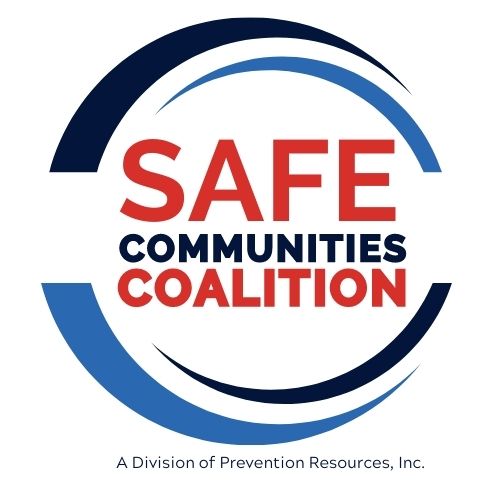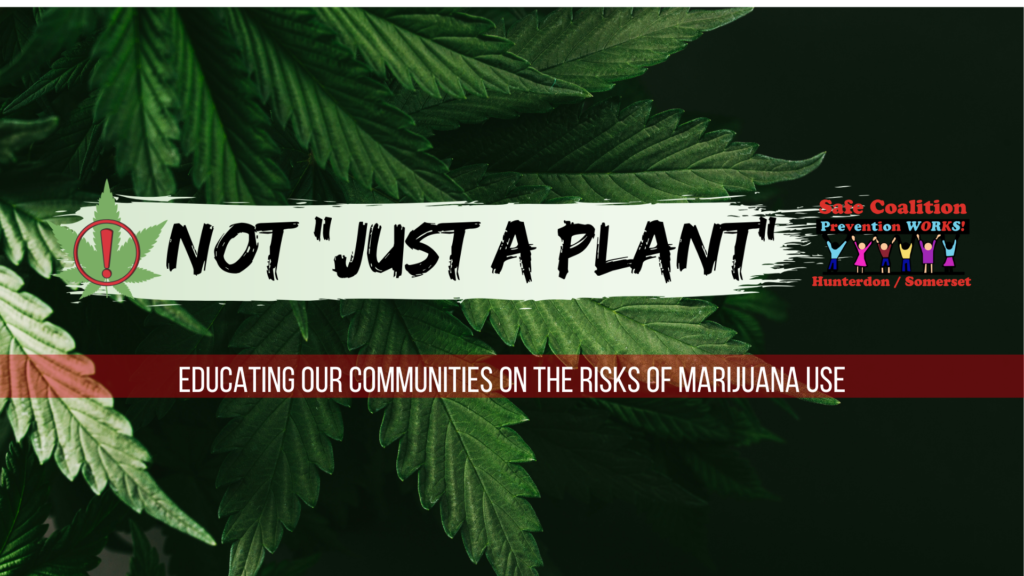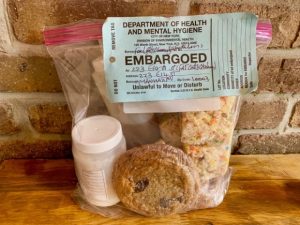
Not Just A Plant was created by Safe Communities Regional Coalition of Hunterdon and Somerset, Prevention Resources, Inc. to educate our community on the most recent scientific data regarding marijuana use, and how marijuana use impacts various sectors of our society. We are working to provide information to youth, parents, business owners, local legislators, school faculty members, and the community at large with the goal of helping our community make informed decisions about marijuana.
Events
May 13, 2021 - What Parents Need to Know About Cannabis
Watch the event recording below. While gift cards are no longer available please fill out this survey at the end of the recording to aid in our local data collection- https://www.surveymonkey.com/r/3XDWW7B
Watch the event recording below.
Information Materials
Fast Facts
- Marijuana is the most commonly used drug in the United States.
- In 2018, more than 11.8 million young adults reported marijuana use in the past year.
- Over the past few decades, THC potency in the marijuana flower has continued to increase. The increase between 1995 and 2015 was 212%, and has continued to increase since.
- Every day, 3287 teens use marijuana for the first time.
- Teenage marijuana use is at its highest level in 30 years. In 2019, 6.6% of 8th graders, 18.4% of 10th graders, and 22.3% of 12th graders reported past month marijuana use.
- Approximately 1 in 10 marijuana users will become addicted. For people who begin using younger than 18, that number rises to 1 in 6

Not "Just a Plant"
- Today’s marijuana is extremely potent
- In the 1960’s, the average amount of THC in the marijuana plant was 1-2%. Today, it averages at around 15%, and can be as high as nearly 30%.
Figure 1 https://www.drugabuse.gov/drugs-abuse/marijuana/marijuana-potency
- Such high amounts of THC greatly increase the chances of suffering from the developmental, physical, and psychological risks which can result from marijuana use, including a heightened risk of addiction.
- Users who use high potency products are more likely to use the drug at least once a week, twice as likely to have used illicit drugs within the past 12 months, and more than three times as likely to be tobacco smokers.
Figure 2 https://www.justthinktwice.gov/facts-about-marijuana-concentrates
- THC concentrates are a highly potent marijuana extract.
- They are created by extracting THC from the cannabis plant. There are many different types of concentrates, including wax, hash, and oils. Methods used to make concentrates include various chemical processes, extreme heat, and alcohol distillation.
- Concentrates are much more potent than the cannabis flower. Marijuana concentrates can contain a THC potency of up to 90%.
Figure 3 Stock Photo
- Edibles are marijuana food products. They are made by infusing marijuana concentrates with food ingredients.
- It is difficult to properly gauge how much THC is being consumed when using an edible as there is no reliable way to measure the exact potency of THC in food products.
- They pose a much higher risk for accidental overdose, as they take a long time to metabolize in the body. Which creates a delay between the time of consumption and the time effects are felt. This produces a false belief that the product is not working. When this happens, users tend to consume more of the product, and unintentionally ingest toxic amounts of THC.
- They also pose a risk for accidental ingestion, as they are often unmarked, and made as candy or baked goods. Packaged products are sometimes nearly identical to popular candy and other children’s products, putting young children at an especially high risk.
Figure 4Marijuana edibles may appear in packaging that resemble children-oriented products

Effects of Legalization: Lessons Learned
Figure 5https://www.denverpost.com/2017/01/31/colorado-roadway-fatalities-surge-2016/
- In 2014, 43.6% of drivers in Colorado and Washington reported driving under the influence of marijuana at least once in the past year. Of those surveyed, 23.9 % reported driving within one hour of using marijuana at least five times in the past month.
- Compared to neighboring states that have not legalized marijuana for recreational use, marijuana related motor-vehicle crashes in Washington, Oregon, and Colorado has increased by 6%.
- In 2018, drivers who tested positive for marijuana use were implicated in 18.2% of traffic fatalities in the state of Colorado, marking a 109% increase since statewide legalization was implemented.
- Since being legalized for recreational use in 2012, past month marijuana use in Colorado residents ages 12 and older has increased by 58%, and is now 78% higher than the national average.
- As states continue to legalize marijuana, perception of harm decreases, and teen marijuana use increases.
Figure 6 Source: National Institutes of Health
- In states that have legalized marijuana for recreational use, the prevalence of Cannabis use disorder in youth 12 to 17 years-old increased by 25%.
- In Colorado, from 2013 to 2017, the yearly number of marijuana-related hospitalizations increased 101%.
- In 2017, Colorado experienced 21,769 emergency department visits and 16,614 hospitalizations connected to marijuana. This is a 300% increase since pre-legalization.
- The Rocky Mountain Poison and Drug Center reported 266 marijuana-related exposures in 2018 overall with 147 of those affecting youth ages 0-18 years-old.
Figure 7 Source: https://rmhidta.org/files/D2DF/FINAL-Volume6.pdf
- Marijuana tax revenue represented less than 1% of Colorado’s FY 2018 budget. It was allocated towards health care, health education, substance abuse prevention, drug abuse treatment programs, and law enforcement.
- In Colorado, for every dollar gained in tax revenue, approximately $4.50 is spent to mitigate the effects of legalization.

Physical Health Concerns
- Marijuana smoke has been shown to contain many of the same toxins, irritants and carcinogens as tobacco smoke.
- Marijuana smoke has been shown to injure the cell linings of the large airways, leading to symptoms such as chronic cough, phlegm production, wheeze and acute bronchitis. A user can also develop chronic bronchitis.
- Marijuana can harm lung tissue and can cause scarring and damage to small blood vessels.
Figure 8 Source: CDC.gov
- The use of “vape-pens” to inhale cannabis concentrates or e-liquids may have similar respiratory health effects as e-cigarette use.
- Vitamin E acetate, an additive found in some THC e-liquids and vaping products, is strongly linked to the EVALI (E-cigarette or Vaping Product Use-Associated Lung Injury) outbreak.
- After the EVALI outbreak, the CDC recommends people not use any THC vaping products, even if purchased from a dispensary.
- People who vape are in the “high risk bracket” of underlying conditions for COVID-19
Figure 9 Source NIDA www.drugabuse.gov
- Marijuana affects specific sites in the brain called cannabinoid receptors. These receptors send messages to different nerve cells throughout the nervous system.
- Marijuana directly affects regions of the brain responsible for attention, memory, learning, coordination, emotion, and reaction time.
- Marijuana can affect a user’s decision making, concentration, and memory for days after the drug was used, especially in those who use marijuana regularly.
- The effect of cannabis temporarily prevents the brain from developing new memories and learning new things. Heavy cannabis users are at risk for developing false memories, even if those users had gone without using the drug for over a month.
Figure 10 Source: https://kushca.com/more-pregnant-women-using-marijuana-study-finds/
- Marijuana is the most commonly used illicit drug by pregnant women.
- Marijuana use among pregnant women rose by 69% between 2009 and 2016.
- The Colorado Pregnancy Risk Assessment Monitoring System reported that maternal marijuana use was associated with a 50% increased risk of low birth weight regardless of maternal age, race, ethnicity, education, and tobacco use.
- Consistent with guidance from the American College of Obstetricians and Gynecologists, the CDC advises against using marijuana during pregnancy

Mental Health
- Marijuana can negatively affect a user’s mental health. The drug can produce psychiatric effects that closely resemble symptoms of schizophrenia, regardless of whether the user uses the drug frequently or occasionally.
- Several studies have linked marijuana use to an increased risk for developing psychiatric disorders, including psychosis, schizophrenia, depression, anxiety, and substance use disorders.
- Studies show a positive correlation between THC potency and rates of mental health disorders.
Figure 11 Stock Photo
- Marijuana use worsens symptoms in users who have mental illness, especially those struggling with anxiety or depression.
- Recent research suggests that smoking high-potency marijuana daily can increase the likelihood of developing psychosis by nearly five times, compared to those who have never used marijuana.
- Marijuana use can trigger schizophrenia in those who are genetically predisposed to the condition.
- Cannabis use disorder is a mental health condition defined by feeling a physical or intense psychological dependence on marijuana, and experiencing withdrawal symptoms when ceasing use.
- Withdrawal symptoms can include: mood changes, sleep issues, cravings and irritability.
- Recent data suggest that 30% of those who use marijuana may be experiencing some degree of cannabis use disorder.
- 1 in 10 marijuana users will develop and addiction to the drug. For users who begin using before the age of 18, the likelihood rises to a 1 in 6 chance.

Teen Use
- After alcohol, marijuana continues to be the most commonly used illicit drug by adolescents.
- After remaining mostly stable for many years, daily use of marijuana went up significantly since 2018 among eighth and 10th graders–now at 1.3% and 4.8% respectively. Teen rates for vaping marijuana have more than doubled in the last 2 years.
Past year vaping of marijuana among teens:
- 20.8% of 12th graders
- 19.4% of 10th graders
- 7.0% of 8th graders
Figure 12 https://www.drugabuse.gov/related-topics/trends-statistics/infographics/monitoring-future-2019-survey-results-overall-findings
- Teen perception of harm has decreased. This is especially true in states that have legalized it for recreational use.
- Decreased perception of harm may increase the likelihood that a teen or young adult will use marijuana.
- Youth will have greater opportunities for access if marijuana is legalized for recreational use. As it is currently with alcohol, it will be accessible in the home, and older friends (ages 21 and up) could legally purchase for the purpose of illegally providing it those who are not of age.
Figure 13 https://www.scientificamerican.com/article/what-pot-really-does-to-the-teen-brain/
- Marijuana use in adolescence is detrimental to the developing brain. Their brains are more susceptible to permanent damage from substance use, as the brain is not fully developed until the age of 25.
- Marijuana can permanently harm the developing youth brain. It can cause permanent damage to areas of the brain responsible for attention, memory, learning, coordination, emotion, and reaction time.
- Youth who regularly use marijuana can show a decline in IQ of up to 8 points. This loss can be permanent.
- Marijuana negatively effects motivation and academic performance. Compared to those who do not use marijuana, students who use the drug are more likely to drop out of high school, and less likely to get a college degree.
- A new study in the American Journal of Psychiatry suggests that cannabis may negatively impact teens’ cognitive development more so than alcohol.
- Nearly 1 in 6 marijuana users who begin in their teen years become addicted.
- As compared to marijuana users who begin their use in adulthood, those who begin as adolescence are approximately 2 to 4 times more likely to develop symptoms of cannabis use disorder within the first two years of use.

Signs your teen may be using marijuana
- If your teen is smoking marijuana, they may exhibit some of the tell-tale signs. These include:
- Blood shot eyes (look to see if they are using eye drops more than usual)
- The “typical” marijuana odor Are they suddenly using mouth wash or cologne that may be hiding the scent of cannabis?
- Small burns on the thumb and forefinger
- Dry mouth, often referred to as “cotton mouth” If your teen is using, they may need to drink more water than usual and have dry mouth more often.
- Increased coughing or breathing issues
- Loss of interest and motivation
- Suddenly abandoning hobbies, clubs, sports or music activities without replacing them with another activity other than “hanging out” with friends.
- No longer motivated to accomplish previously important goals and aspirations
- Drop in academic performance
- Report card shows lower grades than usual
- More trouble concentrating on school work
- Skipping school or increase in school disciplinary actions
- Changes in Mental Health
- Exhibiting symptoms of depression and anxiety, including feelings of sadness, hopelessness, and extreme worry.
- Sudden outburst of anger or hostility.
- Changes in Social Behavior
- Isolating from family members and usual friends
- Suddenly spending a lot of time with a new group of friends.
- Lying about who they are with, where they are, and what they are doing.
- Sneaking out at night
- Generally Odd or Atypical Behaviors
- Sneaking out with friends
- Odd reactions, such as delay in responses or laughing at inappropriate times
- Difficulty remembering things
- Seeming “spaced out”
Figure 15 Vaping Pens. Bongs and other items with THC
- Finding paraphernalia in the home, such as vaping pens, THC cartridges/juices, marijuana stems or seeds, rolling paper, hidden edibles, bongs, etc.
- Today’s paraphernalia can be hidden in plain sight as clothing or other wearable accessories. For example, there are hoodies and accessories designed to hide marijuana products discretely. See pictures below:
Figure 16 Sample items used to hide marijuana https://hightimes.com/culture/best-duds-hide-your-buds/3/
Resources and Support
2ndFloor | Anonymous helpline for NJ youth and young adults 888-222-2228 |
Above the Influence | Help teens stand up to negative pressures, or influences, including the pressure to use drugs and alcohol. |
Hunterdon County Resources | https://www.co.hunterdon.nj.us/humanservices/SubstanceAbuse/Resources.html |
Just Think Twice | Get the facts about drugs |
Marijuana Anonymous | https://marijuana-anonymous.org/ Program to assist recovery from marijuana addiction using the 12 step program |
NJ Connect For Recovery | https://www.njconnectforrecovery.org/ free, confidential call line focused on helping family members and friends coping with a loved one’s substance use disorder 1-855-652-373 |
Partnership for Drug-Free Kids | Resources for parents to help address your child’s substance use. 1-855-378-4373 |
Prevention Resources | https://njprevent.com/early-interventiontreatment/ Licensed by the Division of Mental Health and Addiction Services (DHMAS) as a level 1 outpatient program, offers diverse early intervention and treatment services, including substance abuse evaluations &substance abuse counseling 908-782-3909 |
SAMHSA National Helpline | https://www.samhsa.gov/find-help/national-helpline Free & confidential referral and information service 1-800-662-HELP (4357) |
Somerset County Addiction Resources | https://www.co.somerset.nj.us/residents/covid-19-status/mental-health-substance-abuse |
Paul, Jesse (2017, January 31). CDOT director blames surge in Colorado roadway fatalities on an “epidemic of distracted driving” Retrieved from: https://www.denverpost.com/2017/01/31/colorado-roadway-fatalities-surge-2016/
Centers for Disease Control and Prevention. Substance Use During Pregnancy. (2017) Retrieved from: https://www.cdc.gov/reproductivehealth/maternalinfanthealth/substance-abuse/substance-abuse-during-pregnancy.htm?
National Institute on Drug Abuse. Is there a link between marijuana use and psychiatric disorders? Retrieved from: https://www.drugabuse.gov/publications/research-reports/marijuana/there-link-between-marijuana-use-psychiatric-disorders
Journal of the American Medical Association Psychiatry. (2020, May 27). Association of High-Potency Cannabis Use with Mental Health and Substance Use in Adolescence. Retrieved from: https://jamanetwork.com/journals/jamapsychiatry/fullarticle/2765973
Mammen, G., Rueda, S., Roerecke, M., Bonato, S., Lev-Ran, S., & Rehm, J. (2018). Association of Cannabis With Long-Term Clinical Symptoms in Anxiety and Mood Disorders: A Systematic Review of Prospective Studies. The Journal of clinical psychiatry, 79(4)
Radhakrishnan, R., Wilkinson, S. T., & D’Souza, D. C. (2014). Gone to pot–a review of the association between cannabis and psychosis. Frontiers in psychiatry, 5, 54
National Institute on Drug Abuse, Is Marijuana Addictive? Retrieved from: https://www.drugabuse.gov/publications/research-reports/marijuana/marijuana-addictive
Journal of the American Medical Association Psychiatry. (2019, November 13). Association Between Recreational Marijuana Legalization in the United States and Changes in Marijuana Use and Cannabis Use Disorder from 2008 to 2016. Retrieved from: https://jamanetwork.com/journals/jamapsychiatry/article-abstract/2755276
National Institute on Drug Abuse, Retrieved from: https://www.drugabuse.gov/publications/research-reports/marijuana/available-treatments-marijuana-use-disorders
National Institute on Drug Abuse Retrieved from:https://www.drugabuse.gov/news-events/news-releases/2019/12/vaping-marijuana-rise-among-teens (2019 Monitoring the Future survey)
National Institute on Drug Abuse Retrieved from:https://www.drugabuse.gov/related-topics/trends-statistics/infographics/monitoring-future-2019-survey-results-overall-findings
National Institute on Drug Abuse Retrieved from:https://www.drugabuse.gov/related-topics/trends-statistics/infographics/monitoring-future-2019-survey-results-overall-findings Monitoring the Future is an annual survey of 8th, 10th, and 12th graders conducted by researchers at the Institute for Social Research at the University of Michigan, Ann Arbor, under a grant from the National Institute on Drug Abuse, part of the National Institutes of Health.
Scientific American. (2017, December 1). What Pot Really Does to the Teen Brain. Retrieved from:https://www.scientificamerican.com/article/what-pot-really-does-to-the-teen-brain/
National Institute on Drug Abuse. Retrieved from: https://www.drugabuse.gov/publications/marijuana-facts-teens/want-to-know-more-some-faqs-about-marijuana
Healthline. (2018, October 11). Cannabis May Be Worse for Teen Brains Than Alcohol. Retrieved from:https://www.healthline.com/health-news/cannabis-may-be-worse-than-alcohol-for-teens
National Institute on Drug Abuse (NIDA/NIH). (2019, September 10). Mind Matters: How Does Marijuana Affect Your Brain and Body? Retrieved from:https://youtu.be/JB01nJwBveM
The National Institute on Drug Abuse Blog Team. Marijuana. Retrieved from: https://teens.drugabuse.gov/drug-facts/marijuana
NPR. (2019, August 29). Surgeon General Sounds Alarm On Risk Of Marijuana Addiction And Harm. Retrieved from: https://www.npr.org/sections/health-shots/2019/08/29/755423290/surgeon-general-sounds-alarm-on-risk-of-marijuana-addiction-and-harm
Volkow, N. D., Baler, R. D., Compton, W. M., & Weiss, S. R. (2014). Adverse health effects of marijuana use. The New England journal of medicine, 370(23), 2219–2227. Retrieved from: https://www.ncbi.nlm.nih.gov/pmc/articles/PMC4827335/
Drugwatch. (2020, April 7). Can Vaping Make COVID-19 Risks Worse? Retrieved from:
https://www.drugwatch.com/news/2020/04/07/can-vaping-make-covid-19-risks-worse/
15 Signs of Marijuana Use Parents Need to Watch For. (2014, December 17) Retrieved from: https://www.choosehelp.com/topics/teenagers/marijuana-use-15-signs-parents-need-to-watch-for
Tomicki, H., (2018, May 31) The Best Duds To Hide Your Buds. Retrieved from: https://hightimes.com/culture/best-duds-hide-your-buds/3/




